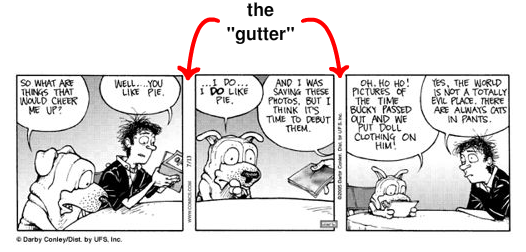WebQuest
Comics - The link between art and literature
Evaluation

The research you have done so far throughout this project has been very important, especially to create your own comic. You are expected to have read through some comics, whilst sharing them with your peers and discussing them. After this, you had to group up in groups of three and set to create your very own comic. The result of this group work will show how much you have learnt from the resources provided, as well as your ability to work sufficiently within a group. Try your utmost to be original!
Your process will be evaluated through an artistic manner, however text and layout combined with the pictures themselves are vital towards making your comic an impressive and fascinating one.
Keep the following points in mind since you must employ the use of both words and pictures within your comic. Also, the texts must be organised into units which are sequential. These must also be graphically separated from each other.
The components of the comic must include the following:
(Please note that the information that follows has been taken from Mario Saraceni, The Language of Comics (Routledge, 2003).)
The Panel:
Each page of a comic is normally composed of six to nine rectangular frames called panels. These usually display single instants of action, also called �stills�. They are sometimes referred to as �frozen moments� and might also be compared to photographs, however their contents must include much more than this. A panel must represent more than simply an instant of the story and this means that pieces of dialogue that are longer than the duration of a camera shot are to be included. The reader of the comic is to consider the panel as a portion which is of a variation of lengths as well as a narrative which takes time. The duration may be represented by the dialogue, the picture in action (such as a book�s pages being flipped), or by the width of the panel itself. The panel border itself can also be modified. This means that it can take the shape of a rectangle with sharp edges, or with rounded ones and these can each represent a different idea or memory.
The Gutter:

Each panel is separated from the others by a blank space and this is called the gutter. This holds its place as a very important element within the comic since it is the space containing all the things which happen between the panels. The reader, therefore must guess the missing elements of the story, thus being able to reconstruct the flow of the story him/herself. The gutter is similar to the space that divides one sentence from the next, leaving the reader to provide certain information which is missing from the narrative themselves. The width of the gutter is not so important and various widths are used. Some comics barely have a gutter.
The Balloon:
This is probably the most famous element of a comic. It is the space in which most of the verbal text is contained. They are used for both reported speech and thought and thus, the terms �speech balloon� and �thought balloon� are used. They are usually found oval or cloud shaped, however variations of balloons exist such as square. The balloon�s tail is an indicator of the character who is speaking or thinking. The tail normally looks like a small pointed projection however is can also be found as a simple line. When the tail is found as a series of small bubbles, this indicates that the balloon is a thought balloon. The function of the tail in general is equivalent to that of clauses such as �he said� or �Diana thought� in reported speech or thought.
The Caption:
This is the other element of comics which contains linguistic elements. The caption is not placed inside the panel, but is always separate, often on top of the panel or at the bottom or on the left side. The text inside the caption is normally the narrator�s voice such as that heard in the background of films. The function of this narrating voice is to add information to the dialogues. It also provides information to help the reader reconstruct the flow between panels, filling the gap which is usually represented by the gutter.
Rubric
| # | Insufficient | Decent | Fine | Excellent | Score |
|---|---|---|---|---|---|
| Research about comics | If nothing is done | If minimal research is found | If required research is looked up | If student finds extra information that was more than required | 25 |
| Read a comic | If no reading is done. | If minimal reading is done. | If the student reads the required text. | If the student goes into the trouble of buying a comic and reading more than is required. | 25 |
| Discuss and interpret | If no discussion or co operation is done in class or among each other. | If a basic analysis has been executed. | If a concrete analysis has been discussed and shows that the students have enough knowledge to proceed to the next task. | If the students show interest not only in discussion and interpretation but also have indulged in the topic of comic art and can easily explain who is who in the world of comics. | 10 |
| Create a comic | If no progress or at least sketches are done at all. | If minimal sketches and panels are created during the task. | If students complete the task and use the notes and information given. | If students complete the task, using real comics as examples and also manage to apply different types of colour schemes and a plotline. | 40 |
Total Score: 100 |
|||||
The Public URL for this WebQuest:
http://zunal.com/webquest.php?w=81436
WebQuest Hits: 9,166
Save WebQuest as PDF